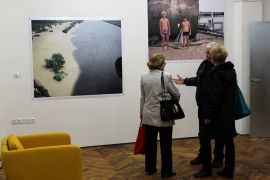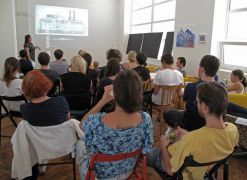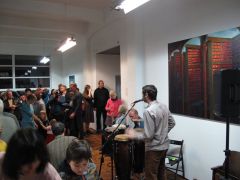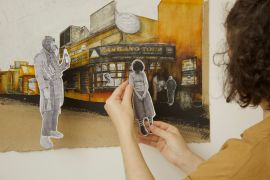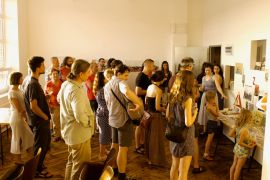High ceilings, huge windows, original hardwood floors – the grandiose proportions are supported by a functional minimalism which immediately draws the visitor’s attention. We are on the third floor of a former textile plant in Rožnov pod Radhoštěm. Local firm Henkai Architects has transformed it into a complex of studios, workshops and offices for creative individuals and small artistic collectives. The marriage of the architects’ vision, coupled with the generous attitude of the current owner, has given the city a new, vibrant space, perfect for exhibitions and for networking for the local arts community. We talked with Vendula Tůmová, one of the main people in charge of the informal 3. Etáž (Third Floor) collective, about what it means to create and support local alternative culture.
AF: How was the 3. Etáž formed, and how is it currently managed?
VT: Some young architects from the Henkai studio returned from Prague after their studies and, together with the photography studio of my husband called BoysPlayNice, set about finding a space for work. They looked long and hard, but only after some time did, they find the vacant space of the former Brill factory, which used to produce woven goods and hosiery. They approached the current owner, Mr. Pavel Sasák, who is the owner of the company Stroza, and he offered them a whole floor, measuring some 600m2. That was too much for just two studios. So, it was finally agreed that the entire floor could be offered to creative people, but under certain conditions.
What are those conditions?
The conditions were that Pavel would finance the renovations, and we would do a feasibility study, run the project, and would lead the construction, and then take care of the promotion and the remaining tenants.
We approached our acquaintances, artists and friends, and made a presentation in the factory space, the first of many. The initiative drew a great deal of attention and many people were interested in the studios, as there was nothing similar in Rožnov. And one of our friends from Henkai Architekti, Michal Nejezchleb, who later died tragically, came up with the idea to use one of the open spaces as a non-commercial gallery. And Pavel agreed.
How does 3. Etáž operate?
The entire 3. Etáž project works on the principle of internal initiative. We did not commit ourselves to anything, so this inner desire must be part of every aspect of our life, our work and family included. There are more of us here, we exchange roles, which is nice and also very important, because each of us also has some livelihood to keep up, and of course their own hobbies, like painting, graphics, photography. When someone finds themselves in a situation where they might not be able to help out, let’s say they are having a busy time at work, or they have very small children, they step aside for a while and the initiative is taken up by someone else. Another principle we keep to is simplicity. If we were to worry about hardline bureaucracy, we would lose interest in it. In the overall strategy for our yearly plan, we work as a board, and everyone has to agree on a course of action.
Who is part of the inner circle right now?
It’s mostly myself, though not long ago it was my husband Martin, who is now busy with his job. Then there’s Lenka Mičolová, her husband Jan Pomykač, and Daniel Baroš from Henkai Architekti. But it varies. Generally, there might be three or four active people who keep the whole thing running.
How do you create your exhibition program?
There are artists who come to us on their own and have proposals, and then we have some ideas of our own. We always agree on those. It’s about fostering discussion – we for example advised one woman from Rožnov to give her work another year and postponed her exhibition. And it turned out great. But the exhibition plan always goes through all of 3. Etáž, as well as those who might not be fully involved. That means garden architects, for example, or glass designers. We ask everyone about tips and ideas. And in January, we talk about it a lot. We have our rules: there will be no political events, and we generally try to agree on the program. We do not follow national trends, but draw on what is happening in Rožnov. We think that there are many good artists here as well. It wouldn’t be a problem to get makers from Prague or Brno, but we want the majority of the program to comprise artists from the region, and ideally to feature the young generation.
How do you divvy up your roles?
One of us approaches the artist, we agree on a date, Lenka creates the graphic material for invitations and posters, and I forward it through our communication channels. We agree on the physical work which needs doing by the wider circle of 3. Etáž, like when we need to paint walls, or install paintings. Our friends from Rožnov bake things for catering. We are basically a fairly small community of like-minded people. The reception refers to us as the intellectual lair.
What do you personally get from working on 3. Etáž?
I have made a home here and found a wider circle of people with whom I resonate and share something in common. It is a service to the place I’m from, and which I am thus able to co-create. Maybe that’s why I couldn’t live in a bigger city. We also do it for ourselves. Before 3. Etáž came around, I wanted to run away from here, I was unhappy. I used to tell my husband, “Martin, take me away from this place.” The home I found thanks to 3. Etáž is very important.
Do you understand the motivations of your patron and his continued support for a non-profit project?
He likes supporting something that makes sense. We welcomed his support as the perfect thing for us, as we can compare it to the municipality’s former policy on culture. We did not interact with the city, as it was a different world, and we didn’t want to ask for grants due to the bureaucracy that that entails. I think he enjoys it, and his motive is the feeling of responsibility towards the place where we live. If he rented out another two cubicles, he wouldn’t make much of a profit from it. So he gave it to like-minded people, and when his and our friends meet at a nice vernissage, it creates an evening which is important for both sides, and that gives us reason to continue.
What kind of relationship do you have with the owner?
Pavel is very interested in what is happening here, and when we need something, he always makes time to listen to us. But he is not involved in the creation of the program.
We need to start informing him a bit more about what happens here. We don’t do it regularly, and that should change. He sort of indicated that he would like to know more about what goes on here. I think he would like to have a list of events. He is very nice.
You’ve been running the space for five years. Looking back, were your early visions in any way naïve, or did things go exactly the way you planned?
It’s been the same for me all this time. We told ourselves we would keep to a certain standard, and that we would not exhibit just anyone who might be interested. And then we have a rule on being apolitical. We also intended our program to consist of multiple genres, because Rožnov is a small town and we want to show people the good things that are happening through various media. An exhibition lasts at least two months, sometimes longer, as we need to have time to appreciate and enjoy the works on exhibit. Furthermore, considering that we are not an institution and that 3. Etáž works on a spontaneous basis, we don’t necessarily have to go about finding a replacement if someone cancels on us.
Do you still consider yourself in a sort of opposition to the city council?
In the time since 3. Etáž started operating, the municipality has become more accommodating. After the elections, new and younger progressives from the Mladý Rožnov (Young Rožnov) initiative became part of the council, and the deputies often come to our exhibitions. We have become accustomed to one another and have become more integrated with the city. It is for example very nice, that when we need projection equipment, we can go to the local library, or if they need a bigger space for an event, we can host it. We have similarly friendly relations with the music community Fujaré, who provide the music program for 3. Etáž.
Do you collaborate with any other like-minded groups?
We are in contact with the Znojmo-based collective Galerie a Prostor – we share information with each other. In the summer, for example, they informed us about a one-man theater show called Cikánský Boxer which we would like to bring to Rožnov. We also communicate with people from Kulturní Prostor Karnola in Hranice and we are in regular contact with Zdeněk Liška and Václav Kocián from the Klar studio who organize architectural lectures at Faunapark in Frýdek-Místek. We would like to invite these and others, and create a shared meeting of similar communities at 3. Etáž, talk about our working mechanisms, our problems and maybe offer each other help.
Did the tragic death of Michal Nejezchleb have an impact on 3. Etáž’s operations?
It did. It impacted all of us who work there. It will never again have the same atmosphere as when Michal was here. He was a unique character. Michal and Dan came up with the idea for 3. Etáž, and Michal was just a very strong personality. He was a very pleasant person and highly skilled architect, a great musician, wonderful friend, and no one here has the same spark as he did. We miss his character, and we will never forget him. We were classmates in high school. He died in the winter of 2017. A train struck him when he was returning home one night. We had the ceremony after the funeral here, at 3. Etáž. The atmosphere was tense. Then we went up to the hill and made a huge bonfire. Each year around mid-December we make a trek up to Radhošť hill. We call it the Mr. Nejez Memorial.
Where do you see the 3. Etáž in 5 years?
We are at a crossroads right now. Five months ago, we talked with Jakub Sobotka, who is the new director of a Rožnov-based cultural agency supported by the municipality, and who organized the current exhibition of Marián Kotrba. And Jakub came up with the idea of founding a gallery of modern art in Rožnov. I said that it doesn’t make sense – Rožnov is a small town – and that we should pool our resources: we can provide the program, you can take care of the production. We are at the moment awaiting the city’s decision. The second part of the story is that we lack education in visual culture – there are no programs for school or Saturday programs for mothers with children. We would like to change this, but 3. Etáž cannot do it, as there is not enough time and space, and we wouldn’t have the time to work our day jobs. Pavel Sasák has a larger, quite fitting space, which is also in the Brill factory compound, in which we could develop the educational program further. We don’t know whether we want to change the friendly and autonomous community we now are, into something a bit more structured, regular, and binding.
Are you going to do it?
We will see. It’s still in its initial stages. I am not yet sure, as we are still feeling each other out. On the one hand, I would like to see Rožnov have an educational program for both children and adults, but I don’t know whether I personally want to do it. What we have now is fairly loose, spontaneous and ours. We are not directly responsible to anyone. The agency is progressive and the city council, with its new board, are trying to get things moving. For them, we are a guarantee of experienced and high-quality content. We are still waiting on whether the city will support the plan both financially and in terms of production. If yes, then we can give them our souls, our hearts, our heads. But it will no longer be service to the Universe, as we will be getting something in return.
Interview conducted by Jan Bartoš.


